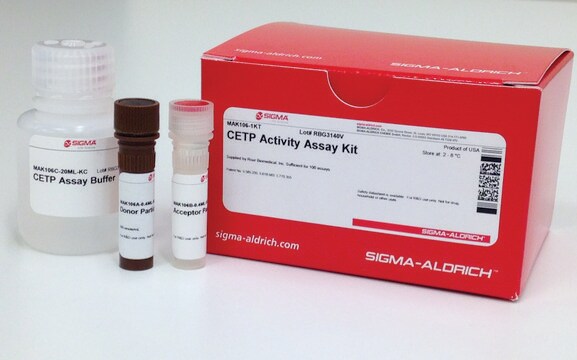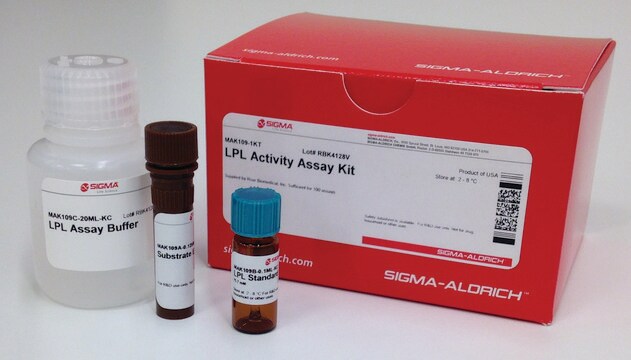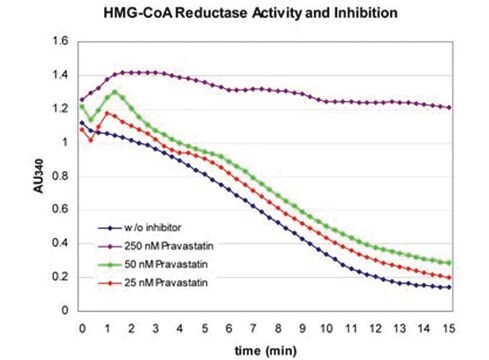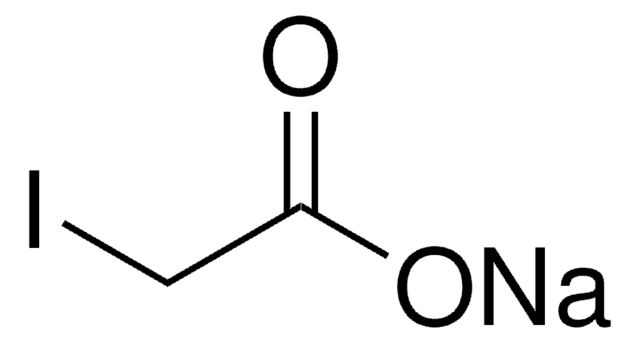MAK107
LCAT Activity Assay Kit
Supplied by Roar Biomedical, Inc.
Sinonimo/i:
Lecithin:cholesterol acyltransferase activity assay kit
Autenticatiper visualizzare i prezzi riservati alla tua organizzazione & contrattuali
About This Item
Prodotti consigliati
impiego
sufficient for 100 fluorometric tests
applicazioni
pharmaceutical
Metodo di rivelazione
fluorometric
Malattie correlate
cardiovascular diseases
Temperatura di conservazione
−20°C
Informazioni sul gene
human ... LCAT(3931)
Descrizione generale
The plasma protein lecithin:cholesterol acyltransferase (LCAT) catalyzes the transfer of an acyl group from the sn2 position of phosphatidylcholine to the 3-hydroxyl group of cholesterol resulting in the formation cholesteryl ester. This enzymatic activity occurs on the surface of high density lipoprotein (HDL). The cholesteryl esters formed by LCAT may be packed into the core of HDL.
Applicazioni
Applications for this method include high-throughput screening, mechanism of action studies and structure-activity relationship (SAR) work.
LCAT Activity Assay Kit has been used for measuring lecithin-cholesterol acyl transferase activity in plasma samples.
Caratteristiche e vantaggi
Compatible with high-throughput handling systems.
Compatibilità
Suitable for measuring phospholipase activity of LCAT in plasma or serum.
Principio
The LCAT Activity Assay Kit is a fluorometric assay useful for measuring phospholipase activity of (λEx=390 nm/λEm=470 nm) LCAT. The assay may be validated by inhibition of LCAT with iodoacetate or another spectrally benign (not Ellman′s reagent) LCAT inhibitor.
Risultati analitici
Solo come componenti del kit
N° Catalogo
Descrizione
- Substrate Reagent .1 mL
- READ Reagent 30 mL
- LCAT Assay Buffer 20 mL
Prodotti correlati
N° Catalogo
Descrizione
Determinazione del prezzo
Avvertenze
Danger
Indicazioni di pericolo
Consigli di prudenza
Classi di pericolo
Acute Tox. 3 Dermal - Acute Tox. 3 Inhalation - Acute Tox. 3 Oral - Flam. Liq. 2 - STOT SE 1
Codice della classe di stoccaggio
3 - Flammable liquids
Punto d’infiammabilità (°F)
49.5 °F
Punto d’infiammabilità (°C)
9.7 °C
Scegli una delle versioni più recenti:
Possiedi già questo prodotto?
I documenti relativi ai prodotti acquistati recentemente sono disponibili nell’Archivio dei documenti.
I clienti hanno visto anche
Reversal of high fat diet-induced obesity through modulating lipid metabolic enzymes and inflammatory markers expressions in rats.
Uddandrao V V S, et al.
Archives of Physiology and Biochemistry, 1-7 (2018)
Anatol Kontush et al.
Arteriosclerosis, thrombosis, and vascular biology, 27(8), 1843-1849 (2007-06-16)
The purpose of this study was to define heterogeneity in the molecular profile of lipids, including sphingomyelin and sphingosine-1-phosphate, among physicochemically-defined HDL subpopulations and potential relevance to antiatherogenic biological activities of dense HDL3. The molecular profile of lipids (cholesteryl esters
Yan Ru Su et al.
Molecular therapy : the journal of the American Society of Gene Therapy, 8(4), 576-583 (2003-10-08)
The antiatherogenic effect of high-density lipoprotein (HDL) and its major protein component apolipoprotein A-I (apoA-I) has been largely attributed to their key roles in reverse cholesterol transport (RCT) and cellular cholesterol efflux. Substantial evidence shows that overexpression of human apoA-I
E Nobécourt et al.
Diabetologia, 48(3), 529-538 (2005-02-25)
Elevated oxidative stress, hyperglycaemia, and dyslipidaemia involving low levels of HDL particles are key proatherogenic factors in type 2 diabetes mellitus. We examined the relationship of oxidative stress, and the degree of glycaemia and triglyceridaemia, to antioxidative function of HDL
Ameliorative potential of gingerol: Promising modulation of inflammatory factors and lipid marker enzymes expressions in HFD induced obesity in rats.
Naidu P B, et al.
Molecular and Cellular Endocrinology, 419, 139-147 (2016)
Il team dei nostri ricercatori vanta grande esperienza in tutte le aree della ricerca quali Life Science, scienza dei materiali, sintesi chimica, cromatografia, discipline analitiche, ecc..
Contatta l'Assistenza Tecnica.








